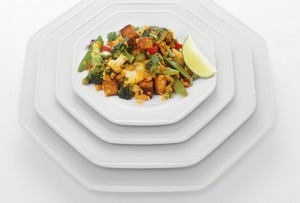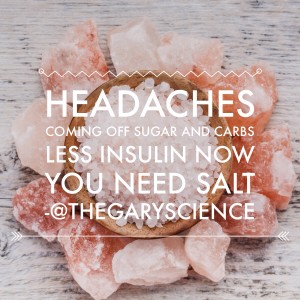- Glucose is a fast acting appetite suppressant.
- Fructose is a potent prolonged appetite stimulant.
- Think of Sugar and Fructose as CHEMICALS – not as something that tastes good.
IDEAS
It is really simple. The glucose half of sugar tells that you have had enough and the fructose half makes you hungry for the next day.
That is the chemical reaction that is meant to keep you, the hunter gatherer, under that fruit tree at the end of summer, gorging away to make fat for winter hibernation.
I used to think that I had no willpower when it came to food but now I understand that it is a chemical called Fructose that is influencing my entire hunger mechanisms. With that knowledge comes control.
You can still have some sugar in your diet as long as you know what it is actually doing to you for the next couple of days afterwards. The big problem with society is the massive amount that we are having it three times a day, 365 days a year. This problem starts from almost the time we are weaned off breast milk.
Two phases of Sugar Withdrawal
The first phase involves substituting something for the sweetness. That is when you can use other sweeteners. Ideally glucose (from chemists) or dextrose (Brewers shops). These are really just glucose and not as sweet as sugar.
It is probably okay to have some artificial sweeteners in this transition – diet soft drinks, cordials and lollies but I am NOT going to recommend an enormous amount.
There are a variety of natural sweeteners being marketed at present including Stevia.
The second phase involves just going without that ‘sweet’ requirement.
I gain the impression that this phase may take 6 to 12 months, so don’t panic when the urge is still there. You just get used to cooking and eating without sweeteners.
Vegetables, milk and even nuts taste sweet and food becomes tastier. That longstanding sweetness of sugar has been dampening your taste for years.
____________________________________
Artificial Sweeteners
Artificial Sweeteners are useful in coming off the ‘sweetness’ dependency. They are akin to using Methadone for Heroin withdrawal. They help you get across the line.
More is known about the effects of artificial sweeteners from the literature over the last 40 years then there has been about the effects of fructose and sugar. Most of the study has been on Glucose. Fructose appears to has literally slipped underneath the radar until recent years.
It has been such an integral part of our dietary intake for the last 100 years that I gain the impression that it has simple been overlooked apart from John Yudkin’s work . Whether or not this was purely oversight or part of a corporate cover up, is unknown.
___________________________________
Is Diet Soft Drink Bad For You?

Yes from the panel and yes from me.
Forget the chemical effects of artificial sweeteners for a minute. That gets debated over and over.
Those who drink artificially sweetened drinks on average take in more calories from other food than those who don’t. The reason is uncertain but articles I have come across suggest it may be related to reward behaviour or changes in the gut and bowel organisms.
I still see these artificial sweeteners as a ‘tool’ to coming off the sugars – a bit like methadone for coming off cocaine.
The risk of developing Diabetes seems to be higher with soft drink consumption, both for standard soft drink as well as artificially sweetened drinks.
http://time.com/3628546/diet-soda-bad-for-you/
http://www.ncbi.nlm.nih.gov/pubmed/24432876
http://www.ncbi.nlm.nih.gov/pubmed/24932880
________________________________________
Break Habits
Do you tend to have that chocolate treat after dinner, when you are stressed or at your desk?
Try doing something different rather than looking for a sweet non sugar alternative. What about a walk after dinner, a cheese platter, a pot of green tea? Just mix it up and use your imagination.
You will have more energy after you have given up sugar – just do something with it.
___________________________________
Clear the Pantry Out
- Get rid of all the sweet foods out of the house.
- Cull it completely.
- That takes the option of breaking the concept harder.
______________________________________
Look hard at all the labels
- Learn how to read the labels for what is relevant.
- Always take the lowest sugar option and ideally keep it under 2% or 2.0 grams per 100 grams
______________________________________
Smaller Plate Sizes
Cut portion sizes down by using an entree plate for every meal.
The dinner plate of the 1950’s was the size of our current entree plate! No wonder we are ‘stuffed’!
___________________________________________
Smelling that Sweet Sensation
Are you after that ‘sweetness’ hit? Are you still having that craving when that cake is put out at work? It’s hard when you are surrounded by temptation every day and others around you are ‘ribbing’ you about your new ideas about the evils of sugar. It doesn’t worry me and here’s one of my tricks.
Desserts hint. Try just smelling the dessert!
Taste is 90% smell. You know that when you have a head cold (or broken nose) your sense of taste disappears.
The ‘sweet hit’ is all about chemical reactions and the nucleus accumbens lies towards the middle of the brain. It is a part of the brain often known as the ‘Pleasure or Addiction’ centre that keeps us ‘wired up’ to go searching for sweetness. We are all meant to be addicted to searching for ‘sweetness’ as a survival mechanism.
Simply looking at a sweet dessert will trigger a response in the nucleus accumbens of the brain. You can still get a “hit” without actually eating the chemical.
Smelling that dessert will still trigger off another response in the ‘Pleasure’ centre.
Once you are off sugar for a fair period of time then you become particularly sensitive to it. I can now inhale the smell of a sweet, chocolate, cake or dessert, feel some degree of satisfaction with it and a second layer of pleasure knowing that I am not actually taking in the chemical nor the calories.
Just try it. You might surprise yourself.
Food
Once you exclude fructose then EAT ONLY WHEN YOU ARE HUNGRY and eat only until you have had enough to be satisfied.
If you are trying to lose weight you still need to watch the overall calories (kilojoules-kJ) taken in but now you will not be taking in the unnecessary ones.
Try www.myfitnesspal.com or the phone app Myfitnesspal – both free and easy to use. Otherwise get a calorie counter book.
Have the majority of your calories at the beginning of each day – then you can burn them off. Have a good breakfast, lighter lunch, and very light dinner.
________________________________
Cut Your Portion Size
Trying to get weight control. Cut your portion size down. You will hear this all the time.
What is a portion size? It just makes everything harder to understand.
Simple rule – Make a fist with your own hand. That is the maximum amount of food that you should take in at a single meal.
One fist sized ‘portion’ of good quality food which is low in sugar and carbohydrate, preferably higher in fat, will keep you going for hours.
The dinner plate of the 1950’s was the size of an entrée plate today. We tend to fill up our plates at meal time otherwise it feels that we are missing out.
So make your plate smaller, cut down the food volume to a fist size and you will not be missing out.
That’s what I make of ‘Portion Size’.
_______________________________________
Hunger
Next time you’re hungry, have a large glass of water. A lot of times when you are thirsty, the brain registers that as hunger.
A large glass of WATER 30 minutes before each meal will distend the stomach so you will feel less hungry by the actual meal time.
Having a GLASS OF MILK at the same time will give you enough glucose to kick in the insulin effect, even before you start the meal. it also has a fat and protein load.
___________________________________
‘New’ Milk Fuel – ‘Super Full’ Cream Milk
Trying to fill up the kids in the morning before school or looking for a super snack.
Make up a batch of ‘Super Full’ Cream Milk – a mix of one third ‘full cream’ in with two thirds of standard milk. Wow. Creamy, filling and takes away that appetite.
Normal full cream milk is about 3.5 – 4% fat. Mix in the straight cream at about 35% fat and this becomes a super fuel.
The galactose gets converted to glucose to break the hunger pang quickly and the fat gives a slow release fuel for hours.
___________________________________
Chewing
Chew each mouthful – take your time to eat. Chewing has an effect on decreasing hunger.
Think of putting your fork or spoon down between mouthfuls.
Sugarless Chewing gum is good for hunger and good for your teeth.
___________________________________
Here is a novel way based on science to get your young children to eat vegetables. I have put a no fructose slant on it that should be worth trying.
I have discussed before that one of our most basic survival instincts is to search for sweetness and if you introduce a sweet food to a baby or child then there is an immediate intake, almost without hesitation.
Every parent knows that if you introduce vegetables or more bitter tastes that it takes several attempts and science suggests between 5-20 exposures of that taste before the child will deem it to be palatable. Vegetables clearly fit into this as, despite having some fructose within them, they can be quite bitter.
Professor Valerie Duffy’s team did pilot work with children by misting the vegetables with some sweetening of a sugar solution. This was a dilute solution that was sprayed on the food just before eating, after cooking. They were not prepared in a sugar solution.
In their study, after 3 or 4 weeks, the children in the intervention group with the lightly sweetened vegetables consumed significantly more vegetables. After exposing the child a few times to the vegetable then you obviously wean off the misting practice.
My take on this information is that the sweetness is the aspect that makes the vegetables more palatable. By making up a light GLUCOSE solution with either GLUCOSE powder or DEXTROSE and misting the vegetables with a dilute solution that was sprayed on the food just before eating and after cooking. Do not prepare the vegetables in a sugar solution.ting a child to start eating vegetables. Vegetables are a great source of many nutrients, without the fructose load of fruit.
So in summary, it would be ideal to have a good exposure to vegetables in pregnancy and certainly whilst breastfeeding. When introducing vegetables to the food intake of a young child, it may be worth considering a light misting of a dilute GLUCOSE solution on the food for a several times to get the child accustomed to that new taste.
(Taken from Facebook blog May 28 2013)
___________________________________________
‘Starving’ Teenagers and What to Feed Them
This question keeps coming back to me. Teenage years are rarely perfect and you are not going to get their diet right – that’s the reality.
Mums wanting and doing the Low Carbohydrate and High Fat (LCHF) option for their family struggle to feed hungry teenagers and particularly boys. I was one of those teenagers migrating from refrigerator to refrigerator, house to house, carb load to carb load.
I was raised on sugar, carbs and polyunsaturated oils and in retrospect this was a long term disaster – fluctuating weight as a child but lost a lot of that weight as a very active sports ‘teenager’.
I was ‘starving’ all day and eating carbs like no tomorrow – cereals, fruit juice, pasta, rice and ice cream come to mind. I used to knock back, just at home, 4 litres of ice cream every week. I think that massive carbohydrate load had a lot to do with all those pimples (acne) I had growing up. Interesting that acne was virtually unheard of in isolated communities until the introduction of the ‘western’ amount of simple carbohydrates.
What to do now with the knowledge I have now about a NoFructose life decision – LCHF and no polyunsaturated oils.
The first is education and leading by example as a parent. I know that sounds easy but if the whole family are on board rather than just one parent it is easier.
Remember that if you start the day with a sugar and carbohydrate load then your teenager will be hungry through the day and have started the yoyo of blood glucose and insulin responses which tend to drive the hunger response.
Get the breakfast right. Get up early and cook that breakfast. Last night’s leftovers of meat and vegetables with some eggs and of cheese thrown into an omelette is a huge energy dense food start.
We have a flat omelette maker and I can make mine in the time frame of making a cup of tea in the mornings. So for teenagers it’s probably going to be twice the size of my omellette.
Add in plenty of nuts and seasonal local fruit.
A glass or two of full cream milk is perfect if they are not lactose intolerant. If that is an issue then the Greek yoghurts may be a better option with a few berries. Keep that milk intake available all day and night for those ‘hunger crises’.
Lastly look at the cereal grains but aim for the high fibre ones which will have less of a blood glucose spike than the refined ones with higher sugar contents. Definitely skip the ones with dried fruits and ‘natural’ honey!
Lunch boxes are tricky but look around the nut options (nut allergies seem to be less of an issue in late high schools), popcorn, cheeses, whole fruit and wraps rather than sandwiches. Look for the wraps with higher fibre content. They are there but requires looking at the labels.
You can see that carbohydrates are sneaking in here but so be it – teenagers are an imperfect science.
Afternoon tea is a bit like lunches. Having EASY access to cut up fresh vegetables, cheeses, milk and nuts. These options require a bit of preparation but that’s why we have refrigerators. Popcorn is a huge filler and lather on the butter.
Dinner is back to normal LCHF and in our house that is generally meat and plenty of vegetables.
We have substituted cauliflower rice for rice and zucchini spirals for pasta. Very little carbohydrate but adds bulk and size to the plate. We have had quite a few teenagers through our home recently and they have survived.
If you are caught out still needing to supply some ‘traditional’ carbohydrate into that ‘starving’ teenager, then look at the wholemeal pasta and brown rice options. Again the higher fibre content slows the glucose spike and insulin response.
Dessert is no longer a regular part of life. Out come the nuts and cheeses in our house.
Good luck and remember that it is just a phase of life! When they are adults they might just realise that you were wiser than they originally thought. Welcome to parenting.
____________________________________________________
No Fructose and Not Losing Weight – What’s the Problem
Facebook Blog August 3 2013
I have had some people who want to lose weight tell me that they have given up sugar and ‘complain’ that they have not lost weight. What else do they need to do?
I saw a lady yesterday who reminded me of this. She has lost 45 kg by eating properly and cutting down her portions. Simple as eating off an entrée sized plate for her. Guess what happened to her knee and body pains – a no brainer.
The dinner plate of the 1950’s is the size of an entrée plate now. We are supersizing ourselves on our plates and then onto our waistline.
Getting rid of sugar out of your daily intake should make you less hungry and you will feel better. After that it is about looking at the calories you are taking in. If you are still not losing weight then you are taking in too much fuel.
Here are a few ideas worth repeating.
Start the day with a good breakfast – protein, fat and a small amount of complex carbs.
EAT ONLY WHEN YOU ARE HUNGRY. Do not eat meals out of habit.
Keep up plenty of water intake. Half an hour before a meal have a large glass or 2 of water.
Thirst is often registered by the brain as hunger. Back to that glass of water. If it still persists then try a glass of milk. The galactose quickly turns into glucose and affects the satiety centre in the hypothalamus and the fat on milk is low GI and keeps you feeling ‘full’.
Do some exercise. It is a great stress reliever and a distractor. You will not burn off a lot of fat whilst in the activity but if you build up some muscle then the resting muscle activity burns up fat 24 hours per day.
Cut way back on the carbs – less bread, pasta, rice and potatoes.
No seconds at the dinner table – if you are desperate for second helpings then force yourself to wait 20 minutes. Most of that urge will go.
Increase the fibre in your diet. It decreases the rate of carbohydrate uptake by the gut with less ‘bounce’ to your blood sugars, it speeds up the transit time of food into your small intestine which gives you that ‘full’ feeling. Processed food just doesn’t do that.
So if you are not losing weight – cut back on the calories, smaller portions of real food rich in fibre and plenty of water and a bit of exercise. All the best.
________________________________________
Cutting back the Carb FLU
Cutting back on your sugar and carbohydrates will generally leave you craving salt on top of the other emotional and chemical ties you have with sugar.
Most of us eating a Lower Carbohydrate and Healthy Fat lifestyle feel the need for more salt. We certainly do in our house.
Here’s the science. Insulin is central once again. Carbohydrate is just glucose.
When you have a food intake full of carbohydrate then that is a massive glucose load to the system. You will be surprised to know how much glucose is in bread, rice, pasta and potato.
The body can only effectively metabolise 1 teaspoon of glucose into the brain and muscle. Anything that you take in above that is turned into fat under the direct effect of insulin. The indirect effect of insulin is to retain salt via the kidneys.
If you have a high carbohydrate load as part of the SAD (Standard Australian Diet) lifestyle then you will be needing to produce a lot of insulin to turn that carbohydrate into fat and that means a lot of insulin production.
That in turn means salt retention and that is linked with fluid retention, hypertension and cardiovascular disease.
Once you decrease the carbohydrate intake then the flow on effect is a relative increase in salt excretion. That in itself is the body normalising but some of you can feel the headaches come on.
Simple remedy is to up the salt intake.
Add salt to the nuts.
Add salt to the meats.
I like salted butter.
Try a spoon of Vegemite.
Add salt to broths which are rich in nutrients.
Natural salt versus Iodised salt?
The purists will argue against iodised salt because of its processing. Here in Tasmania there is a high rate of Iodine depletion conditions such as thyroid disease. Iodised salt has helped the community as a whole.
Are the ‘natural’ salts better. A quick look around the internet reveals an enormous amount of hype and marketing on one form over another. And a lot of chemical analyses suggesting a whole lot of chemicals in the mined rock salts.
The simpleton in me says keep it simple. Evaporated sea salts are probably the cleanest but you still need some Iodine. Other natural sources of Iodine include fish, dairy, eggs and seaweed. So you need real food along the way, particularly if you are in an Iodine depleted community.
#nutritionforlife
You will have some of your own tricks. Please share them and contribute to NoFructose.com







